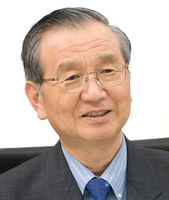










Fujio Masuoka was born on May 8, 1943, in the city of Takasaki, Gunma, Japan, he is the inventor of flash memory. When he was 10, his mother encouraged him to study mathematics and hire a private teacher. By the time he was 12 years old, Masuoka managed to master mathematics.
Studies and his Research Career
In high school, Masuoka concentrated on the theory, believes that advances in technology or electronics is achieved only through theoretical work. As a result of his studies, Masuoka also developed a deep understanding of economics and law. He holds a Bachelor of Science, Master of Science and PhD in electrical engineering from Tohoku University respectively in 1966, 1968 and 1971. Immediately after graduation, Masuoka joined Toshiba Research and Development Center in April 1971.
Walking three months in his new job, the boss Masuoka, Dr Yoshiyuki Takeishi, suggesting a memory Ultraviolet Programmable Electrically Erasable Intel Masuoka (UV EEPROM), which was announced a few months earlier. Intel Masuoka then studied in two months and found a new structure, a MOS type memory read-only memory known as Samos Masuoka the first patent in 1972.
Inventor of Flash Memory
Between 1972 and 1984, Masuoka made another significant breakthrough memory, dynamic memory cell mate with a double poly-silicon structure. In 1977, he moved to Toshiba's semiconductor division, where he developed a 1 Mbit DRAM memory.
Masuoka then transferred to Toshiba memory engineered products division in 1980 to begin work on the development of flash memory. He then shifted to the engineering division of Toshiba memory design in 1984, where he perfected and patented the NOR flash memory. He presented his findings at the International Electron Device Meeting (IEDM) in San Francisco. A year later, he progressed to 256 Kbit flash memory. In April 1987, Masuoka back to Toshiba Research and Development Center, where he began to work to develop more advanced NAND-type flash memory flash disk embryo. Although groundbreaking, flash is not ready for commercialization.
To create and produce pre-fabricated commercial 4 Mbit flash memory chips, Masuoka required to develop high technology projected for the various circuit patterns on each layer of the microprocessor. But to make the technology cost estimates is 10 million yen, the Toshiba initially reluctant to invest. Masuoka convince Toshiba's consumer electronics research executives that 4 Mbit flash memory chip can be used for consumer digital camera into the flash memory that serves as a "digital film." With funding from the consumer electronics division, Masuoka continued to develop and present flash 4 Mbit NAND-type flash memory at the Conference on Solid-State Circuits (ISSCC) in New York City in 1989.
In 1994, Masuoka joined Tohoku University where he was a professor for 13 years before being appointed as Professor of the University Research Institute of Electrical Communication. For his pioneering work on flash memory, Masuoka has received numerous honors and awards in Japan including the Prize of the prime minister of Japan Watanabe in 1977 and the National Invention Award in 1980. In 2007, Masuoka was awarded the Purple Ribbon Medal from the Emperor Akihito.
Flash is not only growing in size alone, but the form and function is also changing. There is a flash drive that uses a rotary design so we do not have to worry about losing the lid. There are also rubber coated flash drive that comes with a waterproof or carabineer clip so easy to hang. Even the flash drive has been created in the form of credit card model. His name is wallet-friendly USB. Its size is just 86 x 54 x 1.9 mm. Thus, it can be stored safely in a wallet.
For safety concerns owned flash drives currently limited to protect the data that is not accessible by non-owners. The workings are in use today such as using full disk encryption or physical authentication tokens. New system introduced mid-year 2005 and is biometric fingerprinting. However, this method is very expensive security because it uses high technology in fact the use of flash drives has been developed for a variety of things. For example, in an article described the steps settings to a flash drive to boot Windows XP. The main requirement is the motherboard and the BIOS of the computer we can support the management of booting from a flash drive. Some applications can also be run from a flash drive without having to install it first to your computer.
IEEE Morris N. Liebmann Memorial Award